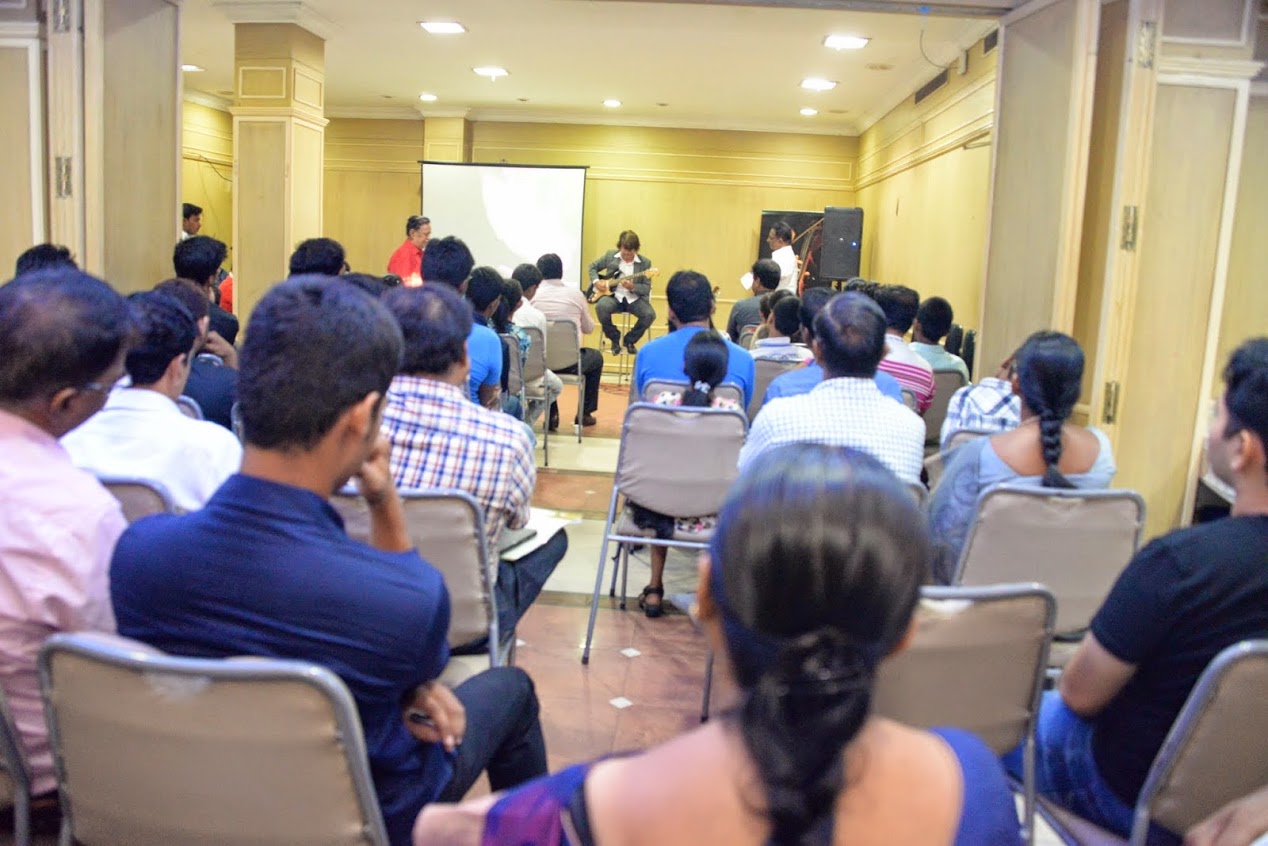BLENDING OF INDIAN RAGAS WITH WESTERN SCALES
A WORKSHOP BY WADINLARA – 2HRS

Indian classical – An overview
1. Indian classical music has two distinct styles-Hindustani classical music and Carnatic music. Hindustani music is prevalent all over India except in the Southern States, where Carnatic music is practiced.
2. Indian classical music was based mostly on ”Ragas” or Melody, Each Raga has its own scale consisting of minimum five and maximum seven notes (swaras). A raga has specific ascending (Aaroh) and descending (Avaroh) movements,
Within the confines of a raga, a variety of embellishments could be made without violating the rule
Hindustani Classical
In Hindustani originally, there were six Ragas and thirty-six Raginis (melodies with softer emotions). Hundreds of Ragas were created with the help of these Ragas and Raginis, many of which have become obsolete. In recent times, musicians have composed many more ragas. There are today, approximately, 120-150 ragas in use.
Hindustani follows Thaat system.
Thaat is a system by which different sets of complete scale of seven notes, in ascending order, are formulated to categorize the maximum number of ragas under it. Thaat or Mela is known as the Parental scale. There are ten Thaats under which most of the Hindustani ragas can be catagorised. These Thaats have the names of ragas and they are Bilawal, Khamaj, Poorvi, Kafi, Bhairavi, Kalyan, Bhairav, Marwa, Asavari and Todi.
Similarities and differences between ‘Hindustani’ and ‘Carnatic’ music
Both the styles are monophonic, follow a melodic line and employ a drone (tanpura) with the help of one or two notes against the melody.
Both the styles use definite scales to define a raga but the C arnatic Style employs Shrutis or semitones to create a Raga and thus have many more Ragas than the Hindustani style.
C arnatic ragas differ from Hindustani ragas. The names of ragas are also different. However, there are some ragas which have the same scale as Hindustani ragas but have different names; such as Hindolam and Malkauns, Shankarabharanam and Bilawal.
There is a third category of ragas like Hamsadhwani, C harukeshi, Kalavati etc. which are essentially Carnatic Ragas. They share the same name, the same scale (same set of notes) but can be rendered in the two distinctively different Carnatic and Hindustani styles.
Unlike Hindustani music, C arnatic music does not adhere to Time or Samay concepts and instead of Thaats, Carnatic music follows the Melakarta concept.
The differences are primarily in performance styles North Indian music tends to be smoother, more sensuous in quality South Indian music tends to be more formal and structured.
Differences between Indian classical and Western classical
1. Indian classical music focuses on successive combination of notes (melody), while western systems rely on a vertical, simultaneous combination of notes (harmony).
2. Indian music is essentially monophonic (single melody format or homophonic) while Western music can be polyphonic (multiple notes played or sung in harmonised unison), monophonic or a combination of both.
3. Western classical music is based upon the equal tempered scale, and rests upon melody, harmony and counterpart while Swara and Tala are the two basic components of Indian classical music.
4. Indian classical music are raga based while western music are scale based. Western scales permit all kinds of permutations to get a musical phrase; one can combine notes in any ways they wish. In a raga, if a certain combination of notes, within its scale, doesn’t follow the aesthetics of the raga, then it won’t be permitted. However, a new raga can be spawned to accommodate such phrases.
5. While western music developed and shaped itself into simpler “melodic base” and complex “harmonic development”, with two primary scales namely major and minor, Indian classical music expanded horizontally. Indian classical music has nearly 7. 2 million ragas,but only a few hundreds are performed.
6. Western music has simpler “melodic base” and complex “harmonic development”, with two primary scales namely major and minor.
Raga vs Scale
1. Western scales permit all kinds of permutations to get a musical phrase; one can combine
notes in any ways they wish. In a raga, if a certain combination of notes, within its scale, doesn’t follow the aesthetics of the raga, then it won’t be permitted.
However, a new raga can be spawned to accommodate such phrases. (There’s a carnatic raga based of dheerasankarabaranam to imitate majorscale/chords like phrases)
2. Major, minor scales underwent centuries of harmonic exploration. Vertical relationships are studied and worked out. In raga music, consonance, dissonance relationships are worked out to construct melodies, but vertical relationships are not much explored.
3. In the Major scale, 7th is called the leading tone, for its tenancy to lead to the tonic. In Indian music, tenancies of notes undergo exhaustive study. For each raga, there are some stable notes (apart from tonic) on which on can pause, leading tones, special notes (like the 3rd & 6th in the above Dharbar example) etc.
MORE TO COME IN THIS SECTION////
New concepts in Fusion
Melharmony is a futuristic concept, with solid historical base and a strong relevance for contemporary society that can be enjoyed by the east and the west.
Drawback
Thus the musical ears tuned to melody may not be able to enjoy harmony and vice versa.
GLOSSORY
Khyal is the major vocal style of Hindustani music
Laya(a) is the tempo of the performance
Alap(anam) raga improvisation in free rhythm
Raga(a)(m) is a scale and its associated musical characteristics
Tal(a)(m) is the meter
Sawal-Jawab is the call-and-response rhythmic challenges between soloist and accompanist in Hindustani music